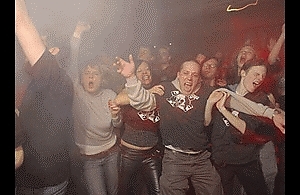This year devoted to BEING BOLD!, CTM presents works reflecting a shift away from the method and medium and back to the message, toward individualist perspectives and personal statements.
The shape of ‘electronic’ and ‘digital’ as defining terms in club-land have lost their integrity. The ubiquity of laptops and the sophistication of production tools has meant that the words – inflated in recent years with all manner of crossover, new and sub genres – have finally split at the seams like carrion and lie flaccid at the side of the road. Club music has crawled out of the mess in a myriad of radically subjective, larval forms, and the days of flat, flickering club visuals are over as the banalities of ‘VJ’ are left to decompose - new forms of music/visual crossover ooze and squirt from restrictive digital tropes.
Club transmediale reflects and affects these transmutations in its program through its cross-pollination policy; where aspects of club culture and electronic music seemed fixed – a techno night with a VJ, a drum and bass event, an ‘experimental evening’ – everything is once again mobile. The program is defined not by style or genre, but by attitude - CTM shows us the pointillist landscape of a wider world, lit by a thousand individual lamps spreading from the margins.
The seventh edition of CTM embraces brazen and risky individualism, place, context and subjectivity, artists that recycle and distort the clichés of the ‘electronic’ and ‘digital’ into new manifestations that challenge with their approach and attitude. In the music program, petrified tropes of techno, drum and bass, glitch and academic electronica are being fished out of the deflated electronic music remains and reapplied as potent fertiliser, spread around with double heapings of parody in the music of Jason Forrest (US), Ilsa Gold (AT) and Guy Tavares (NL) – does this mock-mockery equal sincerity? Nobody knows, but it doesn’t matter – the resulting far flung pockets of fecundity, fresh and full of vigour, are breeding ever divergent strains of creativity that are growing wild.
CTM reaches out not only to the margins, but also back to the formative days of electronic music – acts that were in their time operating under the radar, in pockets of space that nurtured unbounded creativity. A timely re-evaluation of artists in keeping with a pointillist, rather than linear, way of thinking about changes and development in the arts. Electronic music legend Jean Jacques Perrey, who took Pierre Shaeffer’s pioneering tape-splicing techniques and added his own, special dash of humour, will be giving a lecture about his music and approach. And from the wild edges of pre-Krautrock Germany, Limpe Fuchs of Anima Sound will give a special performance.
The strong art/design components are entwined intimately with the music program, exploring music-visual-club connections with organic and fluid forms - the venue Maria at Ostbanhoff will be re-configured and redesigned with site-specific pieces and installations. Murals will be a feature, with an array of hand painted, printed, drawn and silkscreen works - a different artist/collective taking centre stage each evening. Antistrot (NL), Zeeloot (NL) and Seripop (CA) will each create wall-works that don’t shrink from frank political comment and engagement, defining the spaces in their own terms with a diversity of graphic styles.
Artist Carlos Amorales (MX) deals with cultural and social values that relate specifically to his Mexican origins – issues of displacement and transmutation of identity are thrashed out in his art. For CTM he will create a mural centered around fictional characters that are his part of his primary language. Bringing the artistic interventions, comments and retorts in from the street Pabo, Boxi & Kowalski (DE/UK) who use chalk-drawings, stencils, cut-outs and collage to make their anonymous mark on Berlin will create new pieces on main venue’s front façade and in the entrance hall.
In the lounge of the Main venue, a special program of projections, generative works, videos and loops has been choreographed with each evening’s program. Titled Images d'ameublement, it features the work of artists from six countries including Israel, Canada, The Netherlands, Norway and Austria. Even the furniture in the lounge has been designed by an artist collective specifically for the event - poolproducts (DE/FR), the duo Lorenz Wiegand and Nathalie Bruyère, will ‘create inviting furniture made of plasterboard panels’ in a positive statement about artistic inter-contextuality within club spaces.
Motion designer Timm Ringewaldt, in collaboration with video artist Vadim Schäffler and media designer Christian Frey, will present the installation Information Display System, a video info-system developed for specifically for CTM.06 that dispenses program information, situating itself in the divide between service, art and commerce. Sound/Image Archive by Automaten (DE) is also a service-oriented installation. In progress already for almost five years, this audio-visual jukebox invites passers by to contribute to its ever-expanding archive; it sets up at various venues building a unique snapshot of each event.
The scope of the festival extends to an exhibition, Gästeliste +1, that illustrates the hidden side of club culture over the past years of CTM: photos of Berlin’s music scene by Martin Eberle, Marco Microbi and Remco Schuurbiers, and a mobile camera installation, Dokumat 500 from Niklas Roy that will randomly sample the exhibition space and the festival nights, bringing unexpected details of events to light.
Since it’s inception CTM has been more a catalyst than a showcase, less a festival than an organism plumbing the depths with succoured tentacles, and has been instrumental in making connections and building links that criss-cross continents, countries and cultures, bypassing actual and abstract boundaries of space, socio-economics and taste. In 2006 the festival continues to foster open exchange between participants, festival goers, artists and organisers, and more than ever, to bring the underside to the surface – confounding expectations of what the music, art and culture of clubs hold.
